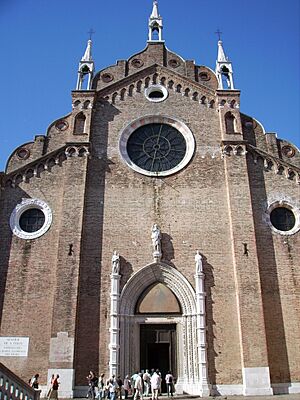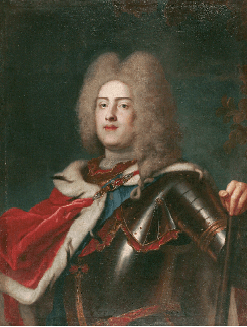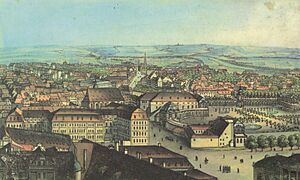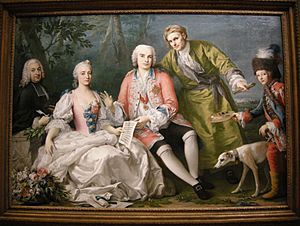Francesco Maria Veracini facts for kids
Francesco Maria Veracini (born February 1, 1690 – died October 31, 1768) was a famous Italian composer and violinist. He is probably best known for his violin sonatas. People at the time thought he had a very unique style of music. One expert, Manfred Bukofzer, said Veracini's style was "individual" and "had no precedent in baroque music," meaning it was unlike anything before it. Another, Luigi Torchi, believed he "rescued the imperiled music of the eighteenth century." Even an asteroid, 10875 Veracini, is named after him!
Contents
Life of a Musical Genius
Francesco Maria Veracini was born in Florence, Italy, on February 1, 1690. His family lived on via Palazzuolo. His father, Agostino Veracini, was a pharmacist. Unlike most of his family, his father was not a musician.
Francesco learned to play the violin from his uncle, Antonio Veracini. He also learned from Giovanni Maria Casini and Francesco Feroci. His grandfather, Francesco, was one of the first violinists in Florence. He even ran a music school from their home. The Veracini family also had a painting studio and a large art collection.
Early Performances and Travels
Veracini became a soloist in Venice, Italy. He performed at Christmas masses in San Marco in December 1711. On February 1, 1712, he played one of his own violin concertos. This was his first recorded public performance of his own music. He played it for a celebration honoring the Austrian ambassador. This event took place in the Santa Maria Gloriosa dei Frari church.
In 1714, Veracini traveled to London, England. There, he played instrumental pieces between acts of operas. He performed his oratorio Mosè al Mar Rosso for important people like Johann Wilhelm, Elector Palatine. In 1716, he became the head of a music school in Venice.
There's a story that another famous violinist, Giuseppe Tartini, was so amazed by Veracini's bowing technique that he went away to practice more. Tartini wanted to improve his own skills after hearing Veracini play.
Veracini wrote violin and recorder sonatas for Prince Friedrich August. The Prince was visiting Venice for carnival. He was looking for musicians for his court in Dresden, Germany. In 1718, the Prince hired Veracini, offering him a very high salary.
Time in Dresden
In Dresden, Veracini was expected to compose music for the court. He was officially made a Kapellmeister, which is a music director, in 1717. In 1719, he traveled to Italy to find more singers for the new Dresden opera house. While there, he also visited his hometown and married Chiara Tesi.
In 1721, Veracini published a set of violin sonatas, his Opus 1. However, there were some disagreements among the musicians at the Dresden court. In 1722, Veracini was involved in a quarrel. This incident led to him falling out of an upper-story window. He broke his foot and hip in the fall. After this, Veracini walked with a limp for the rest of his life.
After the incident, Veracini returned to Florence in 1723. He played music in a church. People sometimes called him "Capo pazzo," which means "head lunatic," because of his reputation. In 1730, he composed a Te Deum for the coronation of Pope Clement XII.
In 1733, his uncle Antonio died. Francesco Maria inherited many valuable violins, including eight made by Jacob Stainer and three by Amati.
Return to London
Veracini returned to London in 1733 and performed in many concerts. In 1735, he composed an opera called Adriano in Siria. Famous singers like Farinelli performed in it. The opera was quite popular, running for twenty performances.
In 1736, he wrote some songs for another opera. In 1737, he composed La Clemenza di Tito. In 1738, Veracini wrote his third opera, Partenio, and then went back to Florence until 1741.
Back in London, he composed his last opera, Roselinda. This opera was based on Shakespeare's play As You Like It, which was an unusual choice for an opera at that time. It was performed in London in 1744. That same year, his oratorio L'errore di Salomone was also performed.
After 1745, Veracini survived a shipwreck. He lost two of his valuable Stainer violins and many of his belongings. He returned to Florence and became the music director for the churches of San Pancrazio and San Gaetano. He focused on church music and mostly conducted in his later years. Veracini died in Florence.
Musical Compositions
Besides his famous violin sonatas, Veracini also wrote many other types of music. These include violin concertos, sonatas for recorder and basso continuo, and orchestral suites, which were called Overtures.
His six Overtures were performed for Prince Friedrich August in Venice in 1716. These helped him get his job at the Dresden court. Veracini also wrote a book about music theory called Il trionfo della pratica musicale. He also edited other composers' works, adding his own "improvements."
Important Works
- 12 Sonatas for recorder or violin solo and basso (written before 1716, not published during his life)
- Opus 1, 12 Sonatas for violin solo and basso (published in 1721)
- Opus 2, 12 Sonate Accademiche for violin solo and basso (published in 1744)
- Dissertazioni del Sigr. Francesco Veracini sopra l'opera quinta del Corelli (a book of musical analysis)
- Opus 3, Il trionfo della pratica musicale (a music theory book, published in 1760)










